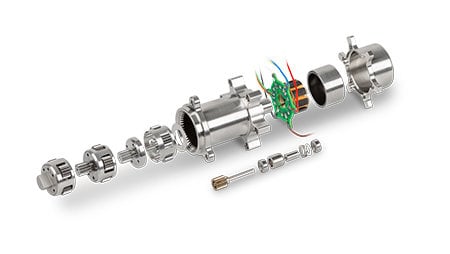www.industryemea.com
12
'20
Written on Modified on
5 challenges an electric motor has to overcome on Mars
Outer space is unforgiving. This is why precision drives embarking on a trip to other planets need to meet extremely high-quality standards.

Every Mars drive from maxon is based on a catalog product and is modified for the specific mission. That’s because the DC motors, gearheads, and encoders face brutal conditions during liftoff, the long journey through space, and the mission on the Red Planet. In this blog, I will talk about the properties a drive needs to have to qualify for a journey to Mars.
Vibration and Shock
The first challenge is to survive the rocket launch. This means that the motor must be resistant to shock and vibration. The vibration is not as strong as people might think: A little more than on a passenger plane, but not much more, and only for a few minutes. Shocks, on the other hand, are something that we need to deal with on a regular basis when working with standard products. These occur mainly during staging, which is when the first stage separates from the rest of the rocket. The resulting forces would destroy normal motors because the rotor would become separated from the stator. That’s why we need to reinforce our drives, for example by encapsulating the rotor and using special welds, special retaining rings, and optimized materials.
Vacuum and Radiation
The trip to Mars takes about six months. During this time, the drives need to survive the vacuum and radiation. The most damaging radiation doesn’t come from the Sun, but from high-energy particles from outside the solar system, which can damage the electronics. That’s why we need specially hardened electronics for the Hall sensors on the motors. To be extra safe, we’re installing them in pairs for redundancy. In a vacuum, the durability of components is important. You can’t use a glue that undergoes changes in its chemical properties and loses its adhesiveness after a few days in a vacuum.
Weight Reduction
Rockets can carry only a limited mass to other planets. To be as light as possible, we also resort to unusual shapes and use thinner housings, or titanium instead of steel. We also often use the smallest possible drive sizes, because we know that the operating time required is usually shorter than for industrial applications. Higher wear is therefore acceptable.
Atmosphere of Mars
After arriving, the motor must work flawlessly for the entire duration of the mission: Due to the thin atmosphere, the lubricants need to be resistant to outgassing and need to retain their properties. Especially for brushed DC motors, it is also necessary to use the right brush mixture. No patina forms on Mars, which is why we developed special brushes impregnated with a lubricant (silver graphite with 15% MoS2). That’s one of the most important modifications, because regular brushed motors fail after only a few hours in a vacuum.
Quality Tests
While drives used on Earth are also tested, there are limits to those tests due to financial considerations. This is different with a Mars mission, where any kind of risk is unacceptable. Here it pays to test every single component. We also test every assembly, and the tests are comprehensively documented. This is how we prove to our customer that the motor is exactly as we promised. The models used on mission must be identical to the units that were qualified, because these were exposed to the same strains in tests as in real life. They were put on a shaker, exposed to temperature cycles, and subjected to durability tests. If the drives pass all these tests, then we can be confident that the design is good. The only remaining step is to build all the other drives in the exact same way—hence all the documentation. The process takes a lot of effort, but it’s worth it: The history of space missions shows that anything that’s overlooked will cause problems—and outer space is unforgiving.
www.maxongroup.com

